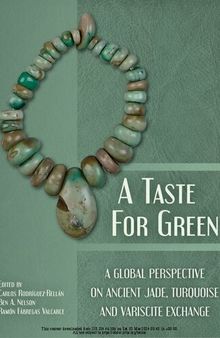 جزییات کتاب
جزییات کتاب
Often along vast expanses, ancient societies traded certain commodities that were considered valuable either for functional or symbolic reasons – or, rather, a mixture of both factors. A Taste for Green addresses latest research into the acquisition of jade, turquoise or variscite, all of which share a characteristic greenish color and an engaging appearance once they are polished in the shape of axes or assorted adornments. Papers explore how, in addition to constituting economic transactions, the transfess of these materials were also statements of social liaisons, personal capacities, and relation to places or to unseen forces.The volume centers on two study areas, Western Europe and México/Southwest US, which are far apart not just in geographical terms but also with regard to their chronology and socioeconomic features. While some North and Mesoamerican groups range from relatively complex farming societies up to state-like organizations during the 1st and 2nd millennia AD, the European counterparts are comparatively simpler polities spanning the 5th–3rd millennia BC. By contrasting the archaeological evidence from diverse areas we may gain insights into the role that production/movement of these green stones played in their respective political and ritual economies. Also, we think it useful to compare the scientific approaches applied to this question in different parts of the globe, specially Asia.Table of Contents1. A colourful past: assessing motivations for the acquisition of turquoise in the ancient U.S. Southwest, Saul Hedquist; Lewis Borck and Alyson Thibodeau2. The Manufacturing traces of the turquoise objects and the lapidary technology from Chaco Canyon: an experimental archaeology approach, Emiliano Melgar3. The presence and potential representation of turquoise at the Mimbres site of Galaz, Will Russell, Sarah Klassen, and Katherine Salazar4. Blue-green Stone Mosaics in the US Southwest and Northwestern Mexico: Origins, Spatiotemporal Distribution and Potential Meanings, Lindsay Shepard, Christopher Schwartz, Will Russell, Robert Weiner and Ben Nelson5. The green stone as a motif for the colonization of the Cañón de Bolaños (Western Mexico), Teresa Cabrero6. Green stones in the centre of Jalisco (Mexico), Lorenza López7. The variscite of Gavà (Spain). Characterisation and system of exploitation and diffusion in the North-East of the Iberian Peninsula, Miquel Molist, Josep Bosch, Anna Gómez, Silvia Calvo and Mònica Borrell8. From the green belt: an appraisal on the circulation of Western Iberian variscite, Carlos Rodríguez-Rellán, Ramón Fábregas Valcarce and António Faustino Carvalho9. Long distance provenances of jewellery (variscite & turquoise) along Atlantic Europe during Neolithic (5th–3rd millennium) based on PIXE analysis, Guirec Querré, Thomas Calligaro, Serge Cassen and Salvador Domínguez-Bella10. Green treasures from the magic mountains: the use of jadeitite and other Alpine rocks in Neolithic Europe, Alison Sherida, Pierre Pétrequin) and Michel Errera11. Spaces and signs of transfer of Jade and Calläis in the Neolithic of Western Europe, Serge Cassen, Pierre Pétrequin, Guirec Querré and Valentin Grimaud



 دانلود کتاب
دانلود کتاب

 جزییات کتاب
جزییات کتاب





 این کتاب رو مطالعه کردید؟ نظر شما چیست؟
این کتاب رو مطالعه کردید؟ نظر شما چیست؟
